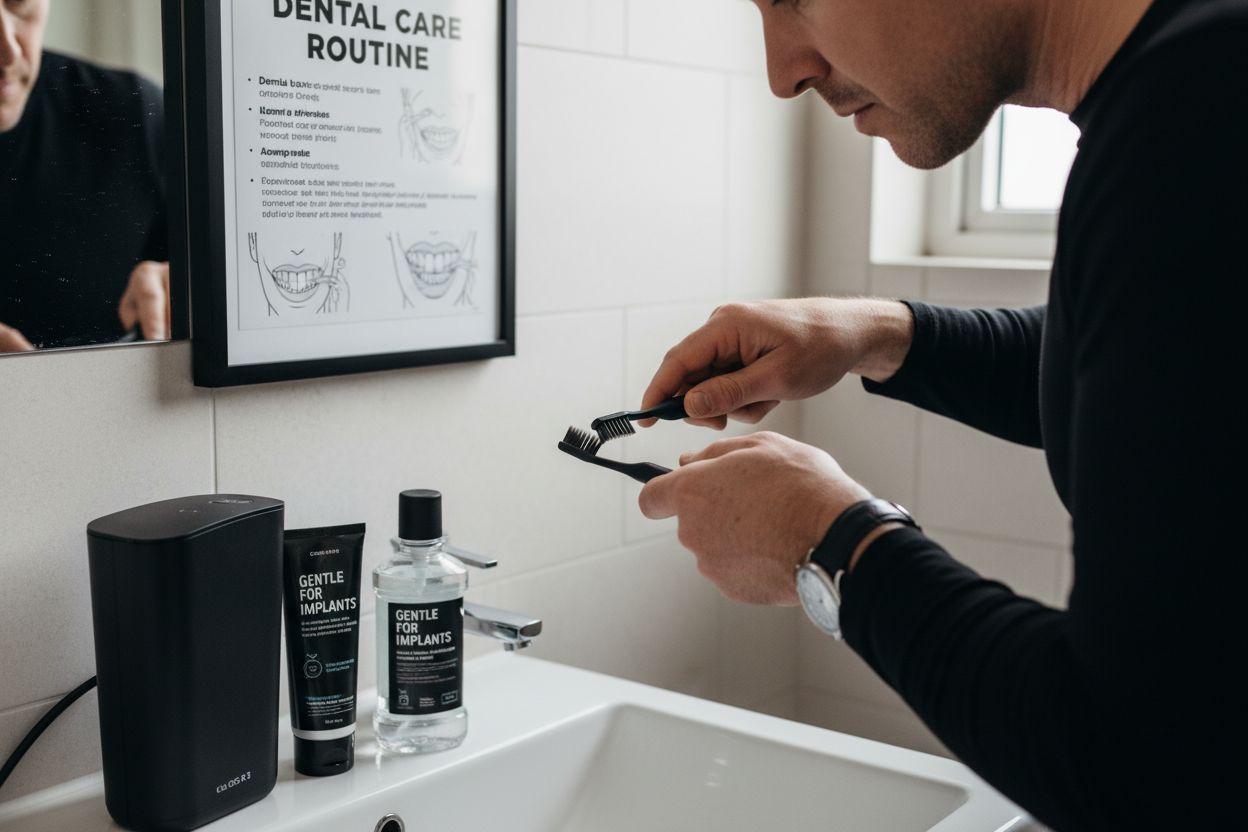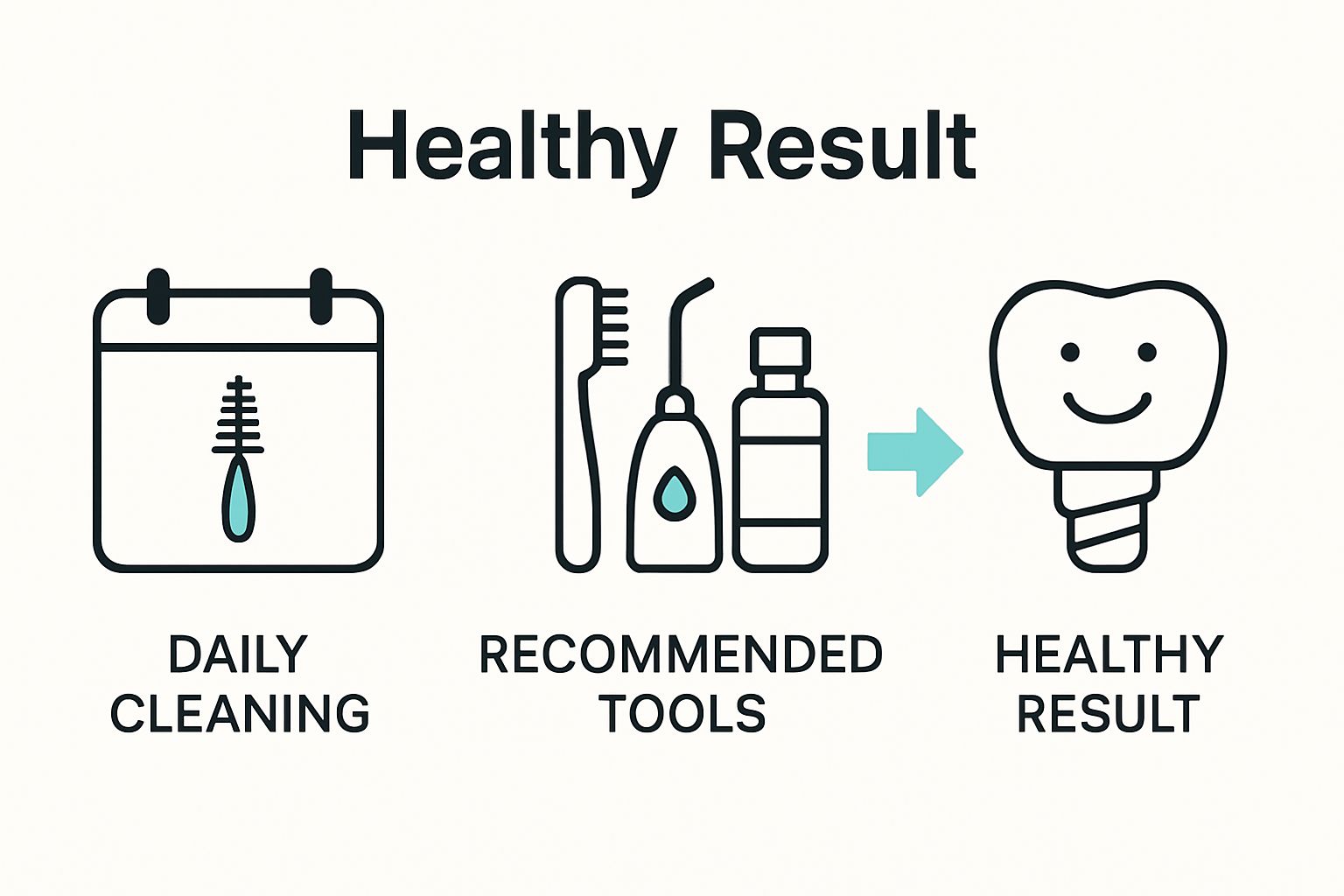
Dental implants promise a brighter, more confident smile and are now the choice of over three million people in North America. Most people think keeping them healthy is just a matter of normal brushing and flossing. The truth is, caring for implants takes a unique approach and even one simple mistake in your daily routine can put your investment at risk.
Table of Contents
- Step 1: Prepare Your Dental Care Routine
- Step 2: Clean Your Implants Daily
- Step 3: Schedule Regular Dental Check-Ups
- Step 4: Monitor For Signs Of Trouble
- Step 5: Adjust Your Diet For Optimal Care
Quick Summary
| Key Point | Explanation |
|---|---|
| 1. Use soft-bristled toothbrushes | These toothbrushes prevent scratches and ensure gentle cleaning around implants. |
| 2. Clean daily with gentle techniques | Adopt a routine that minimizes pressure, focusing on thorough cleaning without damaging implants. |
| 3. Schedule regular check-ups | Visit your dentist every three to six months for professional evaluations to catch issues early. |
| 4. Monitor for discomfort or redness | Be vigilant for signs of infection or issues; early detection is key to preventing complications. |
| 5. Adjust diet for implant health | Eat soft, nutrient-dense foods while avoiding hard or sticky items to protect implants during healing. |
Step 1: Prepare Your Dental Care Routine
Caring for dental implants requires a specialized and meticulous approach to oral hygiene that goes beyond traditional tooth maintenance. Your new dental implants represent a significant investment in your long term health and appearance, demanding a thoughtful and precise care routine that protects their integrity and longevity.
Understanding Implant-Specific Care Needs
Your dental implant care routine must be comprehensive and gentle. Start by selecting soft-bristled toothbrushes specifically designed for implant maintenance. These specialized brushes have gentle bristles that effectively clean around implant surfaces without causing scratches or damage. Electric toothbrushes with pressure sensors can be particularly beneficial, as they help prevent excessive force that might compromise your implant’s structural integrity.
When choosing cleaning tools, prioritize non-abrasive techniques. Use interdental brushes or water flossers that can navigate the unique contours around dental implants. Water flossers offer superior cleaning by reaching areas traditional floss might miss, helping remove plaque and food particles without risking implant surface scratching. According to research from the National Center for Biotechnology Information, customized oral hygiene protocols are crucial for maintaining dental implant health and preventing potential complications.
Keystone tools for your implant care routine include:
- Soft-bristled toothbrush with gentle bristle design
- Water flosser or specialized interdental brushes
- Non-abrasive, implant-friendly toothpaste
- Alcohol-free antimicrobial mouthwash
Consistent technique matters as much as the tools you select. Brush at a 45-degree angle to your gumline, using gentle circular motions that clean without applying excessive pressure. Spend approximately two minutes during each brushing session, ensuring comprehensive coverage around your dental implants. Focus on thoroughly yet carefully cleaning all surfaces, including hard-to-reach areas near the implant base.
Your personalized implant care strategy might benefit from our guide on dental cleaning frequency, which provides additional insights into maintaining optimal oral health. By developing a systematic and gentle approach, you create a foundation for protecting your dental investment and ensuring long-lasting implant performance.
The following table summarizes the key tools and cleaning aids recommended for effective dental implant care, along with their specific purposes.
| Tool/Material | Specification/Feature | Purpose |
|---|---|---|
| Soft-bristled toothbrush | Gentle bristles, electric optional | Prevents scratches, provides gentle cleaning |
| Interdental brush | Non-abrasive, implant-friendly | Cleans unique contours around implants |
| Water flosser | Targets hard-to-reach areas | Removes plaque and debris, reduces abrasion |
| Non-abrasive toothpaste | Specifically for implants | Cleans without damaging surfaces |
| Alcohol-free antimicrobial mouthwash | Gentle, non-irritating | Reduces bacteria and lowers infection risk |
Step 2: Clean Your Implants Daily
Daily cleaning of dental implants requires precision, dedication, and a systematic approach that protects both the implant and surrounding gum tissue. Your goal is to create a thorough cleaning routine that removes bacterial buildup without causing any damage to the delicate implant surfaces.
Morning and Evening Cleaning Protocol
Begin your daily implant care routine by thoroughly rinsing your mouth with lukewarm water to loosen any initial debris. Select a non-abrasive, implant-specific toothpaste that offers gentle yet effective cleaning. Soft-bristled toothbrushes are critical for preventing surface scratches that could compromise your implant’s integrity. Angle your toothbrush at 45 degrees to your gumline, using gentle circular motions that clean without applying excessive pressure.
Research from the National Center for Biotechnology Information emphasizes the importance of specialized cleaning aids for maintaining dental implant health. Water flossers provide exceptional cleaning capabilities, reaching areas traditional floss might miss.
These devices use targeted water streams to dislodge food particles and bacterial biofilm from around implant bases and hard-to-reach areas.
Key cleaning techniques include:
- Use gentle circular brushing motions
- Clean all surfaces of the implant thoroughly
- Spend at least two minutes during each cleaning session
- Rinse with alcohol-free antimicrobial mouthwash
Pay special attention to the areas where your implant meets the gumline. These transition zones are most susceptible to bacterial accumulation and potential inflammation. Move your cleaning tools carefully around these regions, ensuring comprehensive yet gentle coverage. If you notice any bleeding, redness, or sensitivity during cleaning, reduce pressure and consult your dental professional.
Nighttime cleaning is particularly crucial. Remove all food particles and bacterial residue accumulated throughout the day. Consider using an electric toothbrush with pressure sensors that prevent aggressive brushing. Complete your routine by using an interdental brush or water flosser to ensure no debris remains around your implant.
Learn more about maintaining dental implants to gain deeper insights into preserving your dental investment. By developing a consistent, gentle cleaning approach, you protect not just your implants but your overall oral health.

Step 3: Schedule Regular Dental Check-ups
Scheduling regular dental check-ups is a critical component of maintaining the health and longevity of your dental implants. These professional evaluations serve as preventative maintenance, allowing your dentist to monitor implant condition, detect potential issues early, and ensure your oral health remains optimal.
Frequency and Preparation
Plan to visit your dental professional every three to six months, or as specifically recommended by your implant specialist. Frequency may vary depending on individual factors such as overall oral health, healing progress, and potential risk factors. During these appointments, your dentist will conduct comprehensive examinations that go beyond standard cleanings, focusing specifically on the structural integrity and surrounding tissue health of your dental implants.
Research from medical journals highlights the critical nature of regular professional assessments in preventing complications like peri-implantitis, a potentially serious inflammatory condition affecting implant sites. These check-ups provide an opportunity for professional cleaning, detailed inspection, and early intervention if any concerns emerge.
Prepare for your dental appointments by documenting any changes or concerns you’ve noticed:
- Unusual sensitivity around implant areas
- Changes in gum appearance or texture
- Discomfort while eating or speaking
- Any visible shifts in implant positioning
During your check-up, expect a comprehensive evaluation that includes digital x-rays, precise measurements of bone and gum health, and professional cleaning using specialized tools designed for implant maintenance. Your dentist will assess not just the implant itself, but the entire oral ecosystem, checking for potential issues that could impact long-term implant success.
Professional cleanings differ significantly from your home care routine. Dental hygienists use advanced tools and techniques to remove microscopic bacterial buildup that home cleaning might miss. They can access areas around the implant base that are challenging to clean independently, helping prevent potential inflammation or infection.
Explore the benefits of regular dental checkups for a deeper understanding of how these appointments contribute to your overall oral health strategy. By maintaining a consistent schedule of professional evaluations, you’re investing in the long-term success of your dental implants and protecting your oral health investment.
Step 4: Monitor for Signs of Trouble
Monitoring your dental implants for potential complications is a proactive approach that can prevent minor issues from escalating into significant problems. Your ability to recognize early warning signs will be crucial in maintaining the long-term health and stability of your dental investment.
Understanding Warning Signals
Persistent discomfort or pain around your dental implant should never be ignored. While some initial sensitivity is normal during the healing process, ongoing pain could indicate underlying issues such as infection or improper implant integration. Pay close attention to any changes in how your implant feels when eating, speaking, or during routine oral hygiene activities.
Research highlights the critical importance of early detection in preventing more serious peri-implant complications. Visual changes are often the first indicators of potential problems. Watch for:
- Redness or swelling around the implant site
- Bleeding during brushing or flossing
- Visible recession of gum tissue
- Unusual movement or looseness of the implant
- Persistent bad breath or metallic taste
Make it a habit to conduct weekly self-examinations of your dental implants. Use good lighting and a mirror to carefully inspect the implant area, checking for any subtle changes in color, texture, or gum appearance. Gently probe the area around the implant, noting any unusual sensitivity or discomfort. Take photographs periodically to track any visual changes over time, which can be valuable information for your dental professional.
Moisture and bacterial buildup can compromise implant health. If you notice increased sensitivity or changes in how your implant feels, adjust your cleaning technique immediately. Reduce brushing pressure and use specialized implant-friendly tools that clean without causing additional irritation. Soft, gentle motions are key to maintaining implant integrity while preventing potential damage.
Pay special attention to how your implant responds during different activities. Difficulty chewing, unexpected pain when consuming hot or cold foods, or a feeling of instability are red flags that warrant immediate professional consultation. Do not attempt to diagnose or treat potential issues independently.
Below is a troubleshooting table to help you identify common signs of dental implant problems, possible causes, and the suggested action to take.
| Symptom | Possible Cause | Suggested Action |
|---|---|---|
| Persistent discomfort or pain | Infection, improper integration | Consult dental professional |
| Redness or swelling | Inflammation, bacterial buildup | Adjust cleaning, see dentist |
| Bleeding during cleaning | Gum irritation, excessive pressure | Reduce pressure, get checked |
| Gum tissue recession | Gum disease, improper cleaning | Schedule dental evaluation |
| Unusual movement or looseness | Implant instability | Immediate professional review |
| Persistent bad breath/metallic taste | Infection, food debris | Improve oral hygiene, consult dentist |
| Increased sensitivity | Surface irritation, inflammation | Use gentler technique, seek advice |
Learn more about maintaining dental implants to gain deeper insights into protecting your oral health. By remaining vigilant and proactive, you can catch potential complications early and ensure the long-term success of your dental implants.
Step 5: Adjust Your Diet for Optimal Care
Dietary choices play a pivotal role in maintaining the health and longevity of your dental implants. Your nutrition strategy can either support or compromise the healing process and long-term stability of these sophisticated dental prosthetics. Understanding how different foods interact with your implants becomes crucial in preventing potential complications and supporting optimal oral health.
Strategic Nutritional Approach
Initially, focus on soft, nutrient-dense foods during the early healing stages. Protein-rich foods like yogurt, scrambled eggs, and smoothies provide essential nutrients without placing excessive stress on your new implants. These foods support tissue regeneration and minimize potential discomfort during the critical initial recovery period. Gradually introduce more varied textures as your dental professional confirms successful healing and integration.
Research investigating oral health interventions emphasizes the importance of balanced nutrition in supporting dental implant success. Your dietary choices directly impact the surrounding bone and soft tissue health, influencing long-term implant stability.
Consider implementing these dietary guidelines:
- Prioritize foods rich in calcium and vitamin D
- Choose lean proteins for tissue repair
- Include omega-3 fatty acids to reduce inflammation
- Stay hydrated with water
- Limit sugary and acidic food consumption
Avoid extremely hard or sticky foods that could compromise your implant’s structural integrity. Nuts, hard candies, and chewy caramels can create unnecessary stress on the implant and surrounding tissues. When consuming tougher foods, cut them into smaller, manageable pieces and chew carefully using both sides of your mouth to distribute pressure evenly.
Hydration plays a critical role in maintaining oral health. Water helps rinse away food particles, supports saliva production, and creates an environment that discourages bacterial growth. Aim to drink at least eight glasses of water daily, and consider using a straw during the initial healing phases to minimize direct contact with the implant site.
Be mindful of temperature extremes. Very hot or cold foods and beverages can cause sensitivity around the implant area, especially during early healing stages. Allow hot drinks to cool slightly and avoid direct contact with the implant site when consuming extremely cold or hot items.
Learn more about dental nutrition strategies to gain deeper insights into supporting your oral health through thoughtful dietary choices. By making informed nutritional decisions, you create an internal environment that promotes healing, reduces inflammation, and supports the long-term success of your dental implants.

Protect Your Dental Implants with Expert Support in Edmonton
You have invested time and resources into your dental implants, so protecting their longevity is more than just a routine – it is about securing your health, confidence, and daily comfort. It can be stressful to manage specialized oral care at home and recognize early warning signs of trouble. If you want professional guidance and peace of mind, Unity Square Dental is here for you. Our skilled team offers advanced dental technology and customized treatment plans for your unique needs. Ready to take charge of your dental implant care and prevent future complications? Visit our main website for more about our comprehensive approach, and review our practical advice on how to maintain dental implants or dental cleaning frequency for tailored proactive tips.

Do not wait for small problems to become serious. Schedule your personalized implant assessment today at Unity Square Dental and experience accessible, modern care that puts your smile first. Now is the best time to protect your investment in your health.
Frequently Asked Questions
How should I care for my dental implants to ensure they last?
Your dental implant care routine should include using a soft-bristled toothbrush, non-abrasive toothpaste, and water flossers. Brush twice a day at a 45-degree angle to your gumline using gentle circular motions, and make sure to clean around the implant area thoroughly.
How often should I schedule dental check-ups after getting implants?
It is recommended to visit your dentist every three to six months for regular check-ups. This allows your dentist to monitor the condition of your implants and surrounding tissues, helping to identify any potential issues early on.
What signs should I look out for that might indicate a problem with my dental implants?
Look for signs such as persistent pain or discomfort, redness or swelling around the implant site, bleeding during brushing or flossing, unusual movement of the implant, or persistent bad breath. If you notice any of these symptoms, consult your dental professional immediately.
Can my diet affect the success of my dental implants?
Yes, your diet plays a significant role in the health and longevity of your implants. Focus on consuming nutrient-dense, soft foods during the healing process, and ensure you maintain a balanced diet rich in calcium, protein, and vitamins to support tissue health and reduce inflammation.
Recommended
- How to Maintain Dental Implants for Long-lasting Health – Unity Square Dental
- Understanding Dental Implants vs Dentures: What You Need to Know – Unity Square Dental
- Understanding Dental Implants vs Bridges: Which is Best? – Unity Square Dental
- How to Clean Braces Properly: A Step-by-Step Guide – Unity Square Dental
- How to Care for New Implants: Essential Steps for Success – Vacaville Aesthetic Dentistry & Implants

